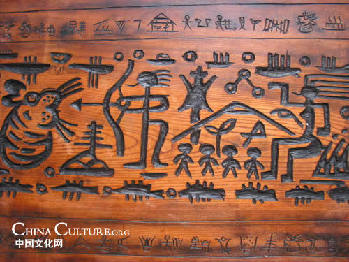
In ancient times men engaged themselves not only in flight with nature, but also in flight among themselves. Therefore sport has yet another aim: to improve the ability to beat the enemy, with or without weapons. During the rule of the Yellow Emperor, who has been held as the first ancestor of the Chinese nation, a rebel tribe headed by Chiyou trained his warriors in fighting with cow horns fastened to the head, which was included in the "one hundred amusements" and developed into various forms of wrestling in later generations. Military training in ancient China included all kinds of martial arts, such as wrestling, pugilism, fencing, tripodlifting, horse-racing, stone-throwing, hunting and swimming. During the Spring and Autumn Period, a high-ranking official in Qi state named Guan Zhong (?-645 BC) ordered the building of swimming pools by conducting the water of three rivers and awarded heavy prizes to good swimmers among his "water troops." A copper pot excavated in Chengdu in Sichuan Province is inscribed with a battle on water in those days. Among the Greeks there is note of occasional swimming races, and a famous boxer swam as a part of his training.
Sports also served military purposes in a ancient Greece, especially in Sparta where all citizens received stoic military training from early childhood, in almost the same sports as in ancient China. According to historical records written during the Period of Warring States, the Chinese kings and emperors ordered their officers to teach archery, charioteering and wrestling in winter and "required the populace to spend six hours farming and two hours practicing martial arts every day."
The ancient Chinese and Greek civilizations shared another thing in common in sporting activities, that is, they were often combined with dancing. A pot in the Neolithic Age excavated in Qinghai Province's Datong County shows on the inside surface three groups of dancers. It is said that in those times China was hit by frequent torrential rains and floods and people suffered a lot from unbroken spells of wet weather. In order to relax their stiffened bones and muscles and dispel their gloomy moods, they would dance a kind of dance that "could conduct the flow of blood and vital energy in the body." The military training in Sparta also included dances and there were choreographic competitions at the ancient Olympic Games. Actually there was little or no difference between physical exercises and dances as is the case with such modern sports as figure skating and artistic and rhythmic gymnastics.
What should be emphasized here is that sports were included in the educational system both in ancient China and Greece. During the Zhou Dynasty and the previous Xia (21st-16th century BC) and Shang (16th-11th century BC) dynasties, all seats of learning were at the same time places for teaching martial arts. The great Chinese philosopher and Educationist Confucius (551-479 BC) was also a good athlete in archery and charioteering and took an active part in fishing, hunting, excursions and hill-climbing. Paying equal attention to moral, intellectual and physical development of his 3,000 pupils, he carried out an educational system of "Six Arts," namely, rituals, music, archery, charioteering, writing and mathematics, which were supplementary to each other. In archery, for instance, he insisted on proper conduct, or what we call "sportsmanship" today, pointing out that an archer should do his best to win and what's more important, "be modest and observe rituals." Besides, he advised people to keep a good eating habit, to abstain from stale dish and meat and not to talk when taking a meal. Such guiding principles were similar to those of the great Greek philosopher Plato (428-348 BC) who held that physical training and sanitation should become an important part of education and that one should train his physique through sports and mould his temperament through music. The curricula at his time included gymnastics, which was broadened to embrace hygiene and dietetics. The Greek gymnasium also taught philosophy, literature and music, and public libraries were nearby.